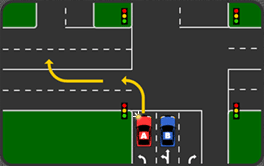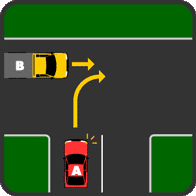Road Safety Trivia Questions Quiz!

For you to get that drivers license, knowing the road safety rules and how to drive on different roads is a very important thing to understand. The road safety trivia questions below are designed to help you practice before the written exam. Give it a shot and all the best in the exam! Read the questions and Images carefully and answer.
- 1.
Which of the following statements are not correct?
- A.
When parrallel parking, drivers must park entirely inside the bay
- B.
When parallel parking, drivers must leave at least one metre from vehicles in front and behind
- C.
If you park in the centre of the road, you can either drive out forwards or reverse out
- D.
Only commercially registered vehicles can park in loading zones
Correct Answer
C. If you park in the centre of the road, you can either drive out forwards or reverse outExplanation
The given statement "if you park in the centre of the road, you can either drive out forwards or reverse out" is incorrect. When parking in the center of the road, it is not possible to drive out forwards as there is no space in front to maneuver the vehicle. The only option is to reverse out of the parking spot.Rate this question:
-
- 2.
Which statement out of the following about pedestrians is not true?
- A.
Drivers who are exiting a public driveway, like a service station or shopping centre do not have to give way to pedestrians
- B.
Drivers must remain stationary at school crossings until all pedestrians are completely off the crossing
Correct Answer
A. Drivers who are exiting a public driveway, like a service station or shopping centre do not have to give way to pedestriansExplanation
The statement "Drivers who are exiting a public driveway, like a service station or shopping centre do not have to give way to pedestrians" is not true. According to traffic regulations, drivers must always give way to pedestrians, regardless of whether they are exiting a public driveway or any other location. Pedestrians have the right of way, and it is the responsibility of drivers to yield to them to ensure their safety.Rate this question:
-
- 3.
In the diagram below, car A wishes to turn left, and then turn right at the next intersection. What should Car A do?
- A.
Proceed through the intersection and go around the block to get to the street they want
- B.
Turn left into the left lane and then move into the right lane when it is safe
- C.
Turn left into the right lane so they can easily make the next right turn
Correct Answer
B. Turn left into the left lane and then move into the right lane when it is safeExplanation
Car A should turn left into the left lane and then move into the right lane when it is safe. This is the correct answer because it follows the proper procedure for making a left turn and then transitioning into the right lane. By initially turning into the left lane, Car A ensures that it is in the correct position to make the subsequent right turn. Moving into the right lane when it is safe allows for a smooth and safe transition to the desired street.Rate this question:
-
- 4.
The intersection below is in a local residential area, and there are no signs or line markings. Car A wants to turn right and car B wants to proceed straight ahead. What is the correct order for the cars to proceed?
- A.
B should give way to A
- B.
A should give way to B
Correct Answer
B. A should give way to BExplanation
In this scenario, the correct order for the cars to proceed is for A to give way to B. This means that car A should wait for car B to proceed straight ahead before making its right turn. Since there are no signs or line markings indicating right of way, the general rule is that the car going straight has the right of way over the car turning. Therefore, car A should yield to car B in order to ensure a safe and smooth flow of traffic at the intersection.Rate this question:
-
- 5.
When a tram is stationary at a tram stop or terminus, the doors of the tram have closed and there are no passengers getting on or off the tram or other pedestrians crossing the road, you may pass the tram if it is safe to do so if you travel at
- A.
20 km per hour or less
- B.
10 km per hour or less
- C.
The designated speed limit
Correct Answer
B. 10 km per hour or lessExplanation
When a tram is stationary at a tram stop or terminus, it is important to pass the tram safely. The correct answer is 10 km per hour or less because traveling at this speed ensures that you have enough time to react to any sudden movements or changes in the tram's doors or passengers. It also allows you to maintain control of your vehicle and avoid any potential accidents or collisions. Traveling at a slower speed in this situation is crucial to ensure the safety of both the tram passengers and other road users.Rate this question:
-
- 6.
What is the legal blood alcohol cocentration level L and P plate drivers
- A.
0.00
- B.
0.05
- C.
0.02
Correct Answer
A. 0.00Explanation
The legal blood alcohol concentration level for L and P plate drivers is 0.00. This means that they are not allowed to have any alcohol in their system while driving. This is because L and P plate drivers are considered to be novice drivers and are subject to stricter rules and regulations in order to ensure their safety on the road. Having a zero tolerance policy for alcohol helps to minimize the risk of impaired driving and potential accidents.Rate this question:
-
- 7.
When you see a driver tailgating you, you should:
- A.
Change lanes to avoid them
- B.
Slow down to send them a message that you’re annoyed
- C.
Speed up
- D.
Tap your brakes
Correct Answer
A. Change lanes to avoid themExplanation
When you see a driver tailgating you, changing lanes to avoid them is the best course of action. This allows you to create more space between your vehicle and the tailgater, reducing the risk of a rear-end collision. Slowing down or tapping your brakes may further aggravate the tailgater and potentially escalate the situation. Speeding up is also not recommended as it can increase the likelihood of an accident. Therefore, changing lanes is the safest and most effective response in this scenario.Rate this question:
-
- 8.
What’s the most dangerous activity that a driver faces each day they drive to work?
- A.
Driving with annoying passengers in the backseat
- B.
Turning left at traffic lights
- C.
Parallel parking
- D.
Freeway driving
Correct Answer
B. Turning left at traffic lightsExplanation
Turning left at traffic lights can be considered the most dangerous activity that a driver faces each day they drive to work. This is because when making a left turn, the driver has to cross oncoming traffic, which increases the risk of accidents. It requires careful judgment of the speed and distance of approaching vehicles, as well as proper timing to ensure a safe turn. Additionally, left turns often involve navigating through multiple lanes of traffic, which can further increase the complexity and potential danger of the maneuver.Rate this question:
-
- 9.
You’ve experienced construction on the way to work and have to detour; when are you legally allowed to do a U-turn?
- A.
When you have visibility of 150 metres in every direction
- B.
When the traffic clears
- C.
When you have visibility of 60 metres in every direction
- D.
Never
Correct Answer
A. When you have visibility of 150 metres in every directionExplanation
When you have visibility of 150 metres in every direction, you are legally allowed to do a U-turn. This means that you have a clear line of sight and can see any oncoming traffic or obstacles from all directions, ensuring that it is safe to make the U-turn maneuver. This requirement is important to prevent accidents and ensure the safety of both the driver making the U-turn and other road users.Rate this question:
-
- 10.
As you drive to and from work, what should you do once the red light turns green?
- A.
Scan the intersection to see if it’s clear
- B.
Press the gas pedal
- C.
Honk at the sleeping driver ahead of you
- D.
Mmediately follow the driver ahead of you into the intersection
Correct Answer
A. Scan the intersection to see if it’s clearExplanation
Once the red light turns green, it is important to scan the intersection to see if it is clear before proceeding. This is necessary to ensure that there are no vehicles or pedestrians still crossing the intersection, which could potentially cause an accident. It is crucial to prioritize safety and be aware of the surroundings before accelerating or entering the intersection.Rate this question:
-
Quiz Review Timeline +
Our quizzes are rigorously reviewed, monitored and continuously updated by our expert board to maintain accuracy, relevance, and timeliness.
-
Current Version
-
Mar 21, 2023Quiz Edited by
ProProfs Editorial Team -
Aug 17, 2010Quiz Created by
A_villanti
 Back to top
Back to top




